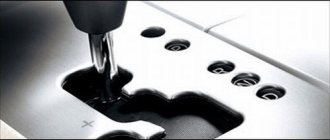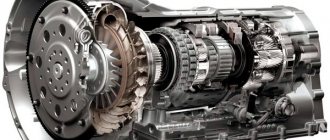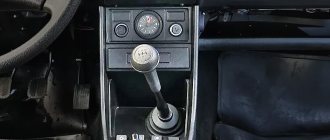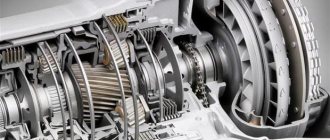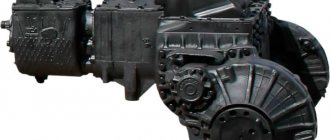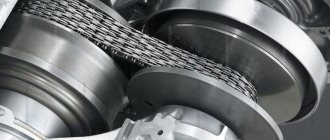Characteristics of the main varieties of this device
Various types of gears are used in the design of the planetary gear set of automatic transmissions. There are three main most common ones: cylindrical, conical and wave.
Cylindrical
Gear mechanisms transmit torque between parallel shafts. The design of a cylindrical gear includes two or more pairs of wheels. The shape of the gear teeth can be straight, oblique or chevron. The cylindrical circuit is simple to manufacture and operate. Used in gearboxes, final drives, drives. The gear ratio is limited by the size of the mechanism: for one wheel pair it reaches 12. Efficiency is 95%.
Conical
Wheels in a conical design convert and transmit rotation between shafts located at an angle of 90 to 170 degrees. The teeth are loaded unevenly, which reduces their ultimate torque and strength. The presence of forces on the axes complicates the design of the supports. For smooth connection and greater endurance, a circular tooth shape is used.
The production of bevel gears requires high precision and is therefore expensive. Angular structures are used in gearboxes, valves, and milling machines. The gear ratio of bevel mechanisms for medium-duty equipment does not exceed 7. Efficiency is 98%.
In wave transmission there are no sun and planetary gears. Inside the crown wheel there is a flexible oval-shaped gear. The carrier acts as a wave generator, and looks like an oval cam on a special bearing.
A flexible steel or plastic wheel is deformed under the action of the carrier. Along the major geometric axis, the teeth engage with the crown to the entire working height; along the minor axis there is no engagement. The movement is transmitted by a wave created by a flexible gear wheel.
In wave mechanisms, the efficiency increases along with the gear ratio exceeding 300. Wave transmission does not work in circuits with a kinematic characteristic below 20. The gearbox produces 85% efficiency, the multiplier - 65%. The design is used in industrial robots, manipulators, aviation and space technology.
The history of planetary hubs for bicycles
Before being used on bicycles, planetary hubs were used on tricycles. The patent for the planetary bicycle hub dates back to the mid-1880s. The first patent for a compact planetary hub was granted in 1895 by American mechanic Seward Thomas Johnson of Noblesville in the USA. This hub only had two speeds. It was not commercially successful.
In 1896, William Reilly of Salford, England, patented a two-speed hub. It began to be produced in 1898 under the name “bushing”. It became a great achievement in the bicycle industry and was produced for many decades. Many people liked the practicality of the compact planetary hub.
In 1902, Reilly designed a 3-speed planetary hub. He stopped working with and gave them the intellectual rights to the planetary hubs. To get around the patent problem, Reilly's colleague James Archer acquired a patent for a 3-speed hub. Meanwhile, the famous English journalist and inventor Henry Starmay also invented his 3-speed hub. In 1903, Frank Bowden, director of the Raleigh bicycle company, created the Three-Speed Gear Syndicate and acquired the rights to both Reilly/Archer and Sturmey 3-speed hubs. The Reilly hub was released as the first 3-speed Sturmey Archer hub.
Two-speed planetary hub Fichtel Sachs Torpedo, produced in 1904 - 1954.
In 1902, Michael Pedersen, who manufactured Dursley Pedersen bicycles, patented a 3-speed hub. It began production in 1903. This hub was based on the "counter-drive" principle, with an unusual planetary gear that used a second sun gear instead of a gear. In 1904, Fichtel & Sachs (Schweinfurt, Germany) released a bushing under the Wanderer license. Thus, until 1909, there were 14 different 3-speed planetary hubs available on the English market.
By 1930, planetary hubs were being used on bicycles all over the world. They were especially popular in the UK, the Netherlands, German-speaking countries and Scandinavia. Beginning in the 1970s, they fell out of favor in English-speaking countries. But in many northern European countries, where bicycles were constantly used as everyday transport, and not just for sport and recreation, planetary hubs were still widely used. Cheaper and more powerful (but less reliable) classic shifters appeared, offering a wide range of gears.
In 1987, Sturmey-Archer only made 3 and 5 speed hubs, Fichtel & Sachs and Shimano only made 2 and 3 speed hubs. That same year, the first book (excluding maintenance instructions) covering 80 years of planetary hub history was published. Since then there has been a slow but steady increase in interest in planetary hubs, which is reflected in the increase in the range of hubs available.
In 1995, Sachs introduced the Elan, the first planetary hub with 12 speeds and a total ratio range of 339%. Three years later, Rohloff came to market with the Speedhub 500/14 14-speed planetary hub, with an overall range of 526% comparable to 27-speed classic shift systems. It was quite reliable and light. This is the only hub that can be mounted on mountain bikes as well as derailers. In 2007, NuVinci launched a continuously variable ∞-speed hub (bicycle CVT) designed for daily commuting, with a total range of approximately 350%.
As of 2008, Sturmey-Archer produced 3, 5 and 8 speed hubs, SRAM (successor of Fichtel & Sachs) produced 3, 5, 7 and 9 speed, Shimano produced 3, 7 and 8 speed . In February 2010, Shimano officially introduced the 11-speed Shimano Alfine 700 model.
While most planetary hubs use a single rear sprocket, SRAM Dual Drive systems combine a planetary hub with a rear derailleur. This results in a wide-range transmission concentrated on the rear wheel. In 2010, Canyon introduced the 1442 hybrid hub, which used a similar planetary gear and derailer combination.
Brompton Bicycle had its own hybrid combination of a special Sturmey-Archer wide range hub with a two-speed derailleur - the "BWR" (Brompton Wide Ratio). The system is targeted at folding bikes where a complex front derailleur can contaminate the folding mechanism of the bike, recumbent bikes and cargo bikes where small wheels and/or increased weight require a wide range of gears with small pitches). In the past, planetary hubs were also used on motorcycles; nowadays they are practically not used.
History of the release of the first models by manufacturers:
- 1902, Sturmey Archer (England) - 3-speed hub with 145% range.
- 1907, Fichtel & Sachs (Germany) - 2-speed Doppel-Torpedo.
- 1995 Shimano - 7-speed Nexus Inter 7 with 244% range.
- 1997, SRAM acquired (Fichtel&) Sachs.
- 1998, Rollhoff AG (Germany) - 14-speed Speedhub 500/14 with a range of 526%.
- 2009 Brompton (England) - 3-speed BWR with 246% range.
Basic functions of the transmission, nuances of use
It is often difficult to answer what a car transmission is, speaking not in specific terms, but in simple words.
To answer the above question, you need to know that the transmission of a vehicle transmits force from the internal combustion engine to the drive wheels and includes a gearbox.
The latter can be either mechanical or automatic.
Features of operation
Structurally, modern transmissions consist of several main parts and mechanisms, which together are responsible for transmitting torque from the internal combustion engine to the drive wheel pair of a vehicle.
The main functions of such a system are:
- change of direction, as well as wheel rotation frequency;
- transmission of force from the internal combustion engine to the drive wheels;
- adjustment and force distribution.
Different types of such systems are installed on modern automobile vehicles:
- Mechanical. In such a situation, mechanical energy is immediately transferred from the engine to the wheels;
- Electric. Here, initially electrical energy turns into mechanical energy and only after that is transmitted to the drive wheels;
- Hydrovolumetric. Here hydraulic energy is converted into mechanical energy and vice versa;
- Combined. A very complex system in which several operating principles are involved.
Purpose and technical characteristics
A vehicle transmission is a complex structural system consisting of components and mechanisms responsible for transmitting mechanical energy to the drive pair of wheels. It is also this system that is responsible for the direction and speed of rotation of the wheels.
The wheel formula is indicated by two numbers. The first of them indicates their total number on the car, and the second indicates the number of driving wheels.
But all-wheel drive can also be engaged manually, but this does not negate the mandatory presence of a transfer case.
Structural components of the transmission
Today there are cars with both rear-wheel drive and front-wheel drive. The transmission of the former consists of the following elements:
- Clutch. Its main function is to disconnect the motor from other elements, making it possible to smoothly switch speeds without jerking and prevent overheating of other parts of the system;
- Gear box. The gearbox makes it possible to change the direction of the wheels, as well as the speed of movement;
- The cardan is another important part of the system, which is responsible for transmitting rotation from the gearbox to the shaft;
- The main gear is responsible for changing the torque and its distribution on the axle shaft;
- The differential is responsible for distributing force between the wheels. Because of this, they can rotate at different speeds. This allows you to perform various maneuvers, in particular turns.
Front-wheel drive vehicles have the same transmission components as rear-wheel drive vehicles. But at the same time, their main gear and differential are built into the gearbox. They are also equipped with CV joints that transmit torque to the wheels.
Hydromechanical transmission: main elements
Hydromechanical transmission is a complex system installed on modern foreign-made cars. Such a system consists of only two structural elements:
- Gearboxes;
- Hydraulic transformer.
In an automatic gearbox, the torque converter is responsible for smooth gear shifting and movement. It is for this reason that cars with such a system are so comfortable to drive, even if the road surface wants to be better.
Automatic transmissions are increasingly in demand, especially among beginners. At the same time, such automatic transmissions have a number of advantages:
- ease of gear shifting, everything happens automatically;
- transmission of torque from the power unit to the wheels occurs automatically smoothly and without jerking;
- comfort of car operation.
In general, a car transmission is an entire system that consists of several parts and assemblies responsible for torque, the transmission of force from the engine to the wheels and its distribution between them.
In fact, we can say that this is one of the most important components in a car. Today you can purchase transmissions with both automatic and manual gearboxes.
How to change gears correctly when riding a bicycle
Transfer case on a VAZ 2121 car. How the Niva transmission works
Strange? Not at all. The planetary mechanism is similar to a manual transmission of a car, and there, too, when switching from one gear to another, the gas is released. And “gas” for a cyclist means pedaling.
You need to switch from one gear to another a little in advance, and this is done like this:
- The bicycle coasts, the effort on the pedals is minimal.
- The gear is changed using the handle.
- After a few rotations of the wheels (about 2 seconds), you can pedal.
Driving uphill is accompanied by a transition to a lower gear, that is, the gear ratio should be less than before the transition. On three-speed planetary gears it's simple: go to first gear. With other options, it is quite normal to switch, for example, from third to second.
You need to go for promotion sequentially, that is, first the first, then the second and so on. When you slow down, you can step over. In monotonous conditions where it is impossible to develop speed (a sidewalk with pedestrians, for example), it is better to use only the main gear without shifting.
Automatic transmission device
Automatic transmission diagram
The automatic transmission device is quite complex and consists of the following main elements:
- torque converter;
- planetary mechanism;
- automatic transmission control unit (TCU);
- friction clutches;
- overrunning clutch;
- hydraulic unit;
- band brake;
- oil pump;
- frame.
The torque converter is a housing filled with a special ATF working fluid and is designed to transmit torque from the engine to the gearbox. In fact, it replaces the clutch. It consists of pump, turbine and reactor wheels, a locking clutch and a freewheel.
The wheels are equipped with blades with channels for the passage of working fluid. A locking clutch is necessary for specific vehicle operating modes. A freewheel (overrunning clutch) is necessary to rotate the reactor wheel in the opposite direction. You can read more about the torque converter here.
The planetary mechanism of the automatic transmission includes planetary gears, shafts, drums with friction clutches, as well as a band brake.
The gear shift mechanism in an automatic transmission is quite complex, and, in fact, the operation of the transmission consists of executing some algorithm for turning the clutches and brakes on and off using fluid pressure.
The planetary gear, or more precisely the locking of one of its elements (sun gear, satellites, ring gear, carrier), ensures the transmission of rotation and changes in torque. The elements included in the planetary gear set are locked using an overrunning clutch, a band brake and friction clutches.
An example of an automatic transmission hydraulic diagram
The automatic transmission control unit can be hydraulic (no longer used) and electronic (automatic transmission control unit). Modern hydromechanical transmission is equipped only with an electronic control unit. It processes sensor signals and generates control signals to the actuators (valves) of the valve body, which ensure the operation of friction clutches, as well as control the flow of working fluid. Depending on this, fluid under pressure is directed to one or another clutch, including a specific gear. The TCU also controls the torque converter lock-up. In the event of a malfunction, the TCU ensures that the gearbox operates in “emergency mode”. The automatic transmission selector is responsible for switching gearbox operating modes.
The following sensors are used in the automatic transmission:
- input speed sensor;
- output speed sensor;
- ;
- selector lever position sensor;
- oil pressure sensor.
You can read more about automatic transmission sensors here.
Design and principle of operation
Design and principle of operation of the multitronic gearbox
The mechanism under consideration is represented by a classic combination of gears with different diameters, which ensure the transmission of rotation with a change in the number of revolutions and transmitted force. The features of the mechanism determine the possibility of application in a wide variety of industries. Operation can only be ensured if the rotating shaft is connected to the driven part.
Considering the drawing of a classic device, it should be noted that it consists of the following elements:
The main elements are represented by gear and worm pairs. To install and fix the main parts, centering bearings are installed. To lubricate the rubbing parts, the housing is filled with special oil
The possibility of leakage can be eliminated by using seals. Oil seals are also an important part of the design. The case consists of two components, due to which it is possible to disassemble the structure during maintenance or repair. The diagram of the classic device is as follows:
The diagram of a classic device looks like this:
- A motor is installed as a source of rotation.
- The other part is represented by a planetary gear. Other parts are located inside; the gearbox housing is attached to the motor using fixing elements.
- Next comes the shaft with bearing.
The structure is protected by the gearbox cover. It is fixed using bolts. In general, we can say that the device is quite complex, so repairing and maintaining it is not always easy.
The operating principle of the unit largely depends on the kinematic diagram of the drive. The calculation of the gear ratio is carried out using special formulas that can be found in the technical literature.
The main part of the structure consists of the following parts:
- Ring gear.
- Planetary or satellites.
- Carrier and sun gear.
The operating principle is calculated as follows:
- The sun gear is located in the central part of the structure. Often the main rotation is transmitted to it, for which the element has a mounting hole for the shaft.
- The central element is constantly in mesh with other similar gears, the axes of which are located around the circle.
- The satellites are meshed with a ring gear, which is represented by a large diameter gear wheel with an internal arrangement of the main parts.
- The carrier is required for rigid fixation of all parts relative to each other.
It is worth considering that for the mechanism to work, one of the parts must be fixed relative to the others. Depending on the choice of the driven or driving element, the gear ratio depends. It is quite difficult to calculate the number; the specific power also depends on this indicator.
The design features of the mechanism under consideration determine that it can be used to achieve a variety of goals.
Disadvantages of planetary bushings
- The main disadvantage is that they are more expensive than a conventional gear shift system. But taking into account the fact that they no longer need to be serviced in the future, the cost of operating the bicycle will be significantly lower.
- Small overall gear ratio. Conventional derailleurs have an average gear ratio of 550%. This means that in one revolution of the pedals in the highest gear the bike will travel 5.5 times greater distance than in the lowest gear. With planetary hubs this ratio is about 300%. It will be difficult to overcome steep climbs and accelerate to high speeds on them. Although progress does not stand still, and engineers from bicycle companies are working to improve the models they produce. There are already good 7, 11 and even 14 speed options.
- They are heavier. Not everything is clear here either. Yes, the planetary hub itself is heavier than a similar hub with a cassette for a multi-speed mountain bike. But by installing it, you also remove from the bike all unnecessary equipment for shifting gears (two front sprockets, leaving only one, one gear shift knob, cables, chain transfer mechanisms, etc.) At the same time, questions about their maintenance disappear . And, in the end, if you are not a bike maniac in terms of weight, then an extra half a kilo does not make any difference for a city bike.
- Repairing them at home is too difficult. For our people, there are no mechanisms that cannot be repaired, but repairing a planetary hub is much more difficult than a regular speed switch. It’s true that they break very rarely.
- Not suitable for high-speed racing and aggressive driving.
- Planetary bushings cannot be used with rear wheel axle cam clamps. This is because if the axle is loosely attached to the dropouts, it can spin and break the hub or frame of the bike.
- Compared to conventional gear shift systems, planetary hubs, due to the many gears, have lower efficiency and more frictional energy loss for the cyclist. They are said to be 92% efficient, compared to 98% for conventional switches.
Procedure for using LAUR
- The flush is poured directly into the old oil through the filler hole in the amount of 100 ml of flush per 1 liter of oil.
- Using a lift or jacks, the driving wheels of the car are suspended in the air.
- The engine starts, then you need to switch gears in random order within 10 minutes.
- After completing this procedure, the old oil with flushing should be drained, and new oil should be poured in its place.
Purpose. This innovative product works on a completely new principle.
Gearbox maintenance is not included in any vehicle service regulations. Sometimes, if necessary, the transmission oil is changed. Oil for this most important component is often selected based on the residual principle that is at hand. If the car was already in someone else’s hands before you, then there are no guarantees that these components have been serviced in any way.
Any service station will definitely tell you that the gear oil in the gearbox changes its color and viscosity characteristics greatly over time. You don't need to be a big specialist to understand the reason for such changes. Any petroleum product oxidizes over time, and in addition, traces of mechanism wear accumulate in it. Such metamorphoses cannot but affect the functionality of the entire unit.
Types of planetary gearboxes
There are quite a large number of varieties of reduction gearboxes. Classification is also carried out according to the number of steps:
- Single stage.
- Multi-stage.
The first version is much simpler, smaller in size and provides greater torque transmission capabilities. The creation of several stages determines a significant increase in the size of the structure, and the range of gear ratios decreases.
The classification is also carried out according to the complexity of the planetary gearbox. There are two main types:
- Simple.
- Differential.
Today, differential gearboxes have become very widespread, as they allow rotation to be transmitted in the required manner in a particular case.
Types are distinguished depending on the shape of the body, as well as the elements used inside. The classification is as follows:
- Wave.
- Conical.
- Worm-shaped.
- Cylindrical or wheel type.
Their use makes it possible to transmit rotation between intersecting, intersecting and parallel shafts. That is why the planetary gearbox has become widespread.
Two-stage planetary gearmotors are used when it is necessary to transmit rotation at different frequencies. Some versions are manufactured according to the 3k scheme, high-power planetary gearboxes are often large in size, and in the manufacture of the main parts, hardened steel is used, which is characterized by high wear resistance.
How does a planetary gear work?
Why do automatic transmissions in the vast majority of cases use planetary gears, and not shafts with gears, as in a manual transmission? The planetary gear is more compact and provides faster and smoother gear changes without interruption in engine power transmission. Planetary gears are durable because the load is transmitted by several planets, which reduces tooth stress.
In a single planetary gear, torque is transmitted using any (depending on the selected gear) two of its elements, one of which is the driving element, the second is the driven one. The third element is motionless.
| Fixed | Leading | Slave | Broadcast |
| Crown | Sun | Carrier | Downward |
| Carrier | Sun | Increasing | |
| Sun | Crown | Carrier | Downward |
| Carrier | Crown | Increasing | |
| Carrier | Sun | Crown | Reverse, downward |
| Crown | Sun | Reverse, boost |
To obtain direct transmission, it is necessary to fix any two elements together that will play the role of a slave link; the third element, when connected in this way, is the master. The general gear ratio of such gearing is 1:1.
Thus, one planetary gear can provide three forward gears (reduction, direct and overdrive) and reverse gear.
The gear ratios of a single planetary gear set do not allow for optimal use of engine torque. Therefore, it is necessary to combine two or three such mechanisms. There are several connection options, each of which is named after its inventor.
Simpson mechanism
A Simpson planetary gearbox consisting of two planetary gearboxes is often called a double row gearbox. Both groups of satellites, each of which rotates inside its own ring gear, are combined into a single mechanism by a common sun gear. A planetary gearset of this design provides three stages of changing the gear ratio. To obtain the fourth, overdrive gear, another planetary gear set is installed in series with the Simpson row. Simpson's scheme has found its greatest application in automatic transmissions for rear-wheel drive cars. High reliability and durability with relative simplicity of design are its undeniable advantages.
Ravignier mechanism
The Ravigneux planetary gear set is sometimes called one-and-a-half, emphasizing the features of its design: the presence of one ring gear, two sun gears and a carrier with two groups of satellites. The main advantage of the Ravigneux scheme is that it allows you to obtain four stages of changing the gear ratio
The absence of a separate planetary overdrive gear makes the gearbox very compact, which is especially important for transmissions of front-wheel drive vehicles. The disadvantages include a reduction in the service life of the mechanism by approximately one and a half times compared to the Simpson planetary gear
This is due to the fact that the gears of the Ravigneux transmission are constantly loaded in all operating modes of the box, while the elements of the Simpson series are not loaded while driving in high gear. The second drawback is low efficiency in lower gears, leading to a decrease in the vehicle’s acceleration dynamics and the noise of the gearbox.
The Wilson gearbox consists of 3 planetary gearboxes. The ring gear of the first planetary gearbox, the carrier of the second gearbox, and the ring gear of the third are constantly connected to each other, forming a single whole. In addition, the second and third planetary gearboxes have a common sun gear, which drives the forward gears. Wilson's design provides 5 forward gears and one reverse gear.
The Lepeletier planetary gear unit combines an ordinary planetary gear set and a Ravinier planetary gear set docked behind it. Despite its simplicity, such a box provides 6 forward gears and one reverse gear. The advantage of the Lepeletye scheme is its simple, compact and light-weight design.
Designers are constantly improving automatic transmissions, increasing the number of gears, which improves the smooth operation and efficiency of the car. Modern automatic transmissions can have up to eight gears.
Features of parallel hybrid transmission
This transmission remains the most technologically advanced by 2021. The system uses the basic elements of the gearbox. The electrical unit is installed in parallel hybrids between the gearbox and the internal combustion engine.
Parallel type hybrid transmission device
The electric motor is connected through the use of several circuits. An 8-speed dual-clutch automatic transmission from the manufacturer ZF can be considered as the first hybrid transmission. The drive axles receive torque from both the internal combustion engine and the electric motor, which also performs the work of the generator.
zf_8-speed dual clutch transmission
The operation of the parallel transmission is monitored and controlled by an electronic module. In a car with a parallel hybrid transmission, it is necessary to use a standard transmission in transient driving conditions. The torque transmitted by two motors will be distributed depending on the driving conditions. At start, during acceleration, an electric motor is connected to the internal combustion engine; during braking and at a stable speed, the electric motor acts as a generator.
The Audi Q5 uses a parallel type of transmission
In cars with parallel transmission, a medium-capacity battery is used with a standard volume and power of the fuel engine. Parallel transmissions are ineffective when driving on city streets, but show excellent dynamics on highways.
The first popular parallel hybrid transmission was designed by Honda engineers. The Integrated Motor Assist system allows you to increase the efficiency of the main engine by 40%, while the amount of spent fuel into the atmosphere remains virtually unchanged, and the vehicle’s environmental performance remains at a low level.
Honda IMA
The IMA unit includes a gasoline engine as the main power unit, an electric motor, and an additional battery for the electric motor. During braking, energy is redirected to the electric motor, which is also used as a generator - the energy does not turn into heat, but is stored in the battery; during acceleration, the electricity is redirected to the electric motor to start its operation. This type of transmission is used by the company to equip the Honda Civic and Honda Insight.
Application
Planetary reductor
The principle has found the widest application in planetary gearboxes, automobile differentials, onboard planetary gears of drive axles of heavy vehicles, in addition, it is used in the summing links of kinematic diagrams of metal-cutting machines, also in drive gearboxes for propellers of turboprop engines (TVD) in aviation, planetary gears are also quite common hubs for bicycles.
Modern devices can use cascades of several planetary gears to obtain a wide range of gear ratios. Many automatic transmissions operate on this principle.
Often planetary gears are used to sum up two power flows (for example, planetary gears of double-flow transmissions of some tanks and other tracked vehicles), in this case there are no fixed elements. For example, two power streams can be supplied to the sun gear and epicycle, and the resulting stream is removed from the carrier. This scheme is widely used in aviation: in the constant speed drive of an electric generator, a planetary mechanism is used to add two different input rotation speeds in order to obtain a stable output. In aviation electric and hydraulic drives, for reliability, two motors are used, operating on a common output shaft through a planetary gearbox, and if one motor or its control circuit fails, the operability of the drive is maintained, but with a double reduction in rotation speed.
Planetary gears are also used in cases where a variable gear ratio is required (can be achieved by braking, for example, a carrier).
Planetary rotation mechanism
PMPs are used on tanks to change speed and turn. In this case, the transmission is equipped with its own planetary gearbox to the left and right driving wheels, the ring gear of which is driven from the engine, torque is transmitted from the carrier to the wheel, and the sun gear is connected to a brake of one design or another (usually a band). Also, a so-called locking clutch is installed between the ring gear and the output shaft, and another brake is installed on the output shaft (from the carrier).
If the sun gear brake and clutch are turned off, then the torque is not transmitted to the drive wheel of the tractor - the crown rotates the disengaged sun gear through the satellites, creating virtually no torque on the carrier. To prevent the tractor from moving in this case, the main brake (on the output shaft) can be braked. If you start to brake the sun gear, the satellites will get a fulcrum and begin to create a moment on the carrier, rotating the drive wheel of the tractor. With the sun gear fully braked, the PMP operates like a regular reduction gearbox. This is the first transfer of PMP. When the locking clutch is turned on, it will begin to transmit torque from the engine directly to the carrier, bypassing the gearbox, and when the clutch is fully engaged, the PMP gearbox will be completely disabled (blocked) - this is the second transmission of the PMP, working as a direct transmission.
Thus, turning on the driver brake stops the tractor, turning on the sun gear brake stops the first (lower) gear, and turning on the locking clutch stops the second gear.
What is a planetary gear
Before considering the structure and principle of operation of the planetary mechanism, it is necessary to identify its purpose. It serves to change the speed (sometimes direction) of rotation of the output shaft.
In the operation of this mechanism, the following dependence can be traced: the lower the speed of the output shaft, the greater the torque on it (in other words, a large ratio of the input and output shafts).
Now we will find out what a planetary gear is, the operating principle of which is based on the rotation of gears. Gears come in the following types:
- sun gear;
- satellites;
- ring gear.
The planetary mechanism gets its name from the placement of gears in it like planets around the sun.
And the diagram is as follows: in the center there is a sun gear, satellites (like planets) spin around it, connected to each other by a carrier, and outside the satellites there is a ring gear. All types of gears can be connected to either an input shaft or an output shaft.
The principle of operation of a planetary gear is that one of the types of gears (sun, carrier or crown) is rigidly fixed. Then this fixed node is the transmitting link.
For example, when attaching a ring gear, the input shaft supplies torque to the sun gear. The same transmits the rotation further to the satellites, which, passing along the ring gear, begin to rotate the carrier. Well, the carrier already outputs torque to the output shaft.
A planetary gearbox is built on this principle, which additionally includes braking and blocking systems for the mechanism components.
Planetary gear operating principle can be of two types:
- Single-stage (only one type of gear is blocked);
- Multi-stage (different types of gears can be blocked).
In addition, the planetary gear set can be either with a fixed element, as we considered earlier, or differential. In the second case, none of the mechanism nodes is rigidly fixed, allowing you to change the rotation independently, based on the forces applied to different shafts of the system.
Its mechanism is designed so that it allows the shaft that is least loaded to rotate faster.
What is automatic transmission and its types
An automatic gearbox is one of the types of transmission in which, without driver intervention, the required gear ratio is set, selected for the driving mode and other factors.
From a technical point of view, only the planetary part of the unit is considered an automatic transmission, which is directly connected to gear shifting, and together with the hydraulic transformer forms a single automatic unit.
Automatic transmissions usually include classic ones with a torque converter, a robotic gearbox and a variator.
Classic automatic transmission
The torque converter gearbox is a popular and classic transmission model, installed on most cars currently coming off the production line.
The automatic transmission consists of a planetary gearbox, a control system and a hydraulic transformer, which gave it its name - torque converter gearbox. Installed on both cars and trucks.
Robotic gearbox
The robot box is a kind of alternative to a manual gearbox, only gear shifting is automated through electrical mechanisms driven by an electronic unit.
The only similarity between a robotic gearbox and a classic automatic transmission is the presence of a clutch in the box body itself.
Variable speed drive
A variator is a device for smooth, stepless transmission of torque to the wheels.
Provides a reduction in fuel consumption and improves dynamic performance, sparing the operation of a vehicle engine compared to an automatic or manual transmission.
Variators are belt, chain and toroidal. Of the variators, the most common is with a V-belt.
What's the result?
As you can see, planetary automatic transmissions and other components based on a planetary mechanism are actively used in the modern automotive industry. Moreover, the mass production of automatic planetary gearboxes has practically replaced manual transmissions in developed countries.
Today, hydromechanical planetary automatic transmissions (automatic transmissions) and CVT continuously variable transmissions (variators) are ubiquitous in passenger cars of various classes, SUVs, trucks, etc.
Due to the convenience and quality of operation, automatic transmissions are very popular, continuing to displace manual transmissions even from the budget segment (for example, Chinese cars with automatic transmissions).
